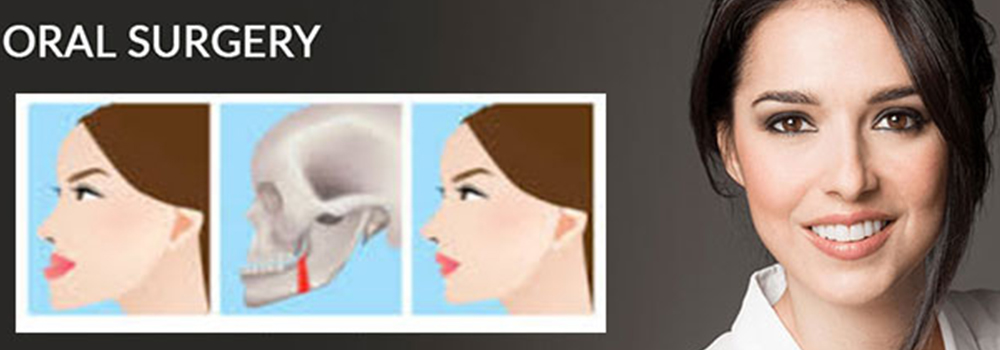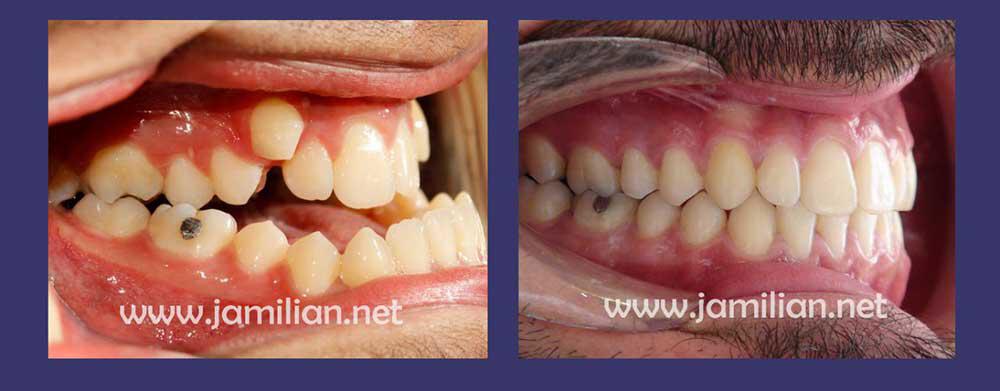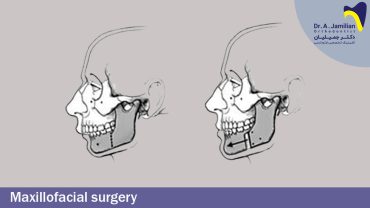Orthodontic surgery is frightening for some patients, this often arises from their insufficient information in this regard. The most important issue is to inform the patients of the advantages and disadvantages of each treatment. The term “orthognathic treatment” refers to orthodontics along with jaw surgery.

If patients with jaw deformities refer an orthodontist before puberty, they can be easily treated with orthodontics alone without any need for surgery. On the other hand, surgery will be required in the case of a late visit. Orthosurgery or orthognathic patients are those with a jaw problem visiting an orthodontist after puberty. These patients first undergo presurgical orthodontics, then to a maxillofacial surgeon, and finally undergo post surgical orthodontics.

Types of orthognathic surgery
On misaligned and crowded teeth we use presurgical orthodontics to arrange the teeth. This is due because the maxillofacial facial surgeon cannot operate the jaws until the teeth are regular. Thus, orthodontics is the prerequisite for surgery. Postsurgical orthodontics is used to further coordinate the operated jaws, improve dental order, correct any tooth rotation and stabilize surgical treatment.
The surgery is performed in a hospital under complete anesthesia. If the maxilla is retruded, which is called maxillary deficiency, it should be extended through a procedure known as maxillary advancement surgery. If the maxilla is protruded, which is called maxillary protrusion, it should be retracted through a procedure known as maxillary set back surgery. If the mandible is retruded, it’s called mandibular deficiency, it’s done through a procedure known as mandibular advancement surgery.
Patients with a protruded mandible or mandibular prognathism undergo mandibular setback surgery, and those with deep bite or open bite undergo Lefort surgery. It should be noted that this is a team treatment performed by an orthodontist and a maxillofacial surgeon. The treatment process must be done correctly; otherwise it’s difficult to achieve the intended results. Maxillofacial surgeries are among simple surgical treatments that often require only one day of hospitalization.
Surgical treatment or orthodontic treatment
Surgical orthodontics or orthognathic treatment FAQ
1- What are the complications of orthognathic surgery?
In general, orthognathic surgery is a safe method, especially if it is performed by an experienced and updated surgeon. Facial nerve damage is among the rare side effects that may occur. However, this complication will not happen if the surgeon is skilled.
2- How long is the recovery period of surgical orthodontics for orthognathic treatment?
The partial recovery of the jaws lasts about 4 weeks, but full recovery takes about 8 weeks. The teeth are aligned by the orthodontist. The tooth movement is done by a fixed orthodontic device. Depending on the orthodontist’s opinion, orthodontic brackets will be on the teeth for 1.5-2 years, and the surgery will be performed one year after the start of the treatment.
3- Is orthognathic surgery painful?
Patients will be anesthetized during the surgery and don’t feel any type of pain. After the surgery and regaining consciousness, they may feel a pain similar to wisdom tooth extraction pain. In this case, the specialist will prescribe a suitable painkiller. This pain will be doubled when chewing food. Therefore, liquid food such as light soup should be eaten in the early days, so that pain and pressure do not affect the jaws.
4- Is orthognathic surgery difficult?
It is one of the most difficult and complex surgeries for the patients. Due to the blood that the patient loses during surgery, it is recommended to take iron supplements for 3 months to prevent the occurrence of anemia after the surgery.
5- How long does orthognathic surgery take?
The orthognathic surgery duration varies depending on the degree and location of abnormality. The surgery duration will be 1-2 hours if the surgery is performed on one of the jaws, while the actual surgery will last 3-5 h or even more if it is performed on both jaws.
6- Is it possible to speak after orthognathic surgery?
The patient would not be able to speak immediately after the surgery. It takes nearly two weeks until you can speak properly. This period varies depending on the degree of abnormality treated and the patient’s physiology. After the surgery, the patient will be able to open their mouth wide enough to fit two fingers between your front teeth two weeks after the surgery.
7- Is the orthognathic surgical incision visible in the face and does it have a scar?
Orthognathic surgery is performed from inside the mouth to correct the position of the jaws. Therefore, scars and cuts will not be visible in the face.
8- What points should be considered in advance for orthognathic surgery?
1. Get some comfortable clothes that have buttons in the front, so that you can wear them easily after the surgery, 2. Taste liquid foods and protein powders that you should eat after the surgery and choose your favorite flavor, 3. Get your prescription from the doctor before the surgery and prepare it, 4. Prepare foods that do not need to be chewed, 5. Get a suitable blender or mixer to soften and puree chewy foods.
9- How long after orthognathic surgery can you return to work?
It will be around 7-10 days until you can return to work. Importantly, It’s recommended not to do physical activities for 4-6 weeks.
10-How to eat after orthognathic surgery?
The first weeks after the surgery are very sensitive. Therefore, it is important to consume small amounts of nutrients slowly throughout the day. Avoid moving your jaws as much as possible. Do not eat any chewable food for two weeks after orthognathic surgery.







